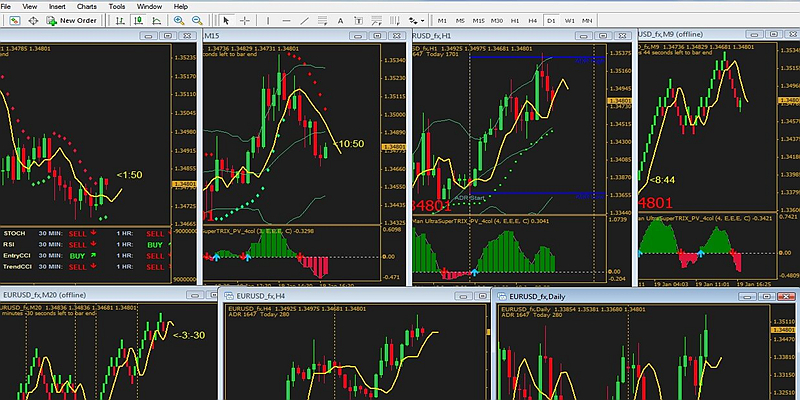7 Common Mistakes in Reading Stock Charts and How to Avoid Them?
Jan 01, 2000 By Sana
Advertisement
Have you ever felt like you need clarification while reading a stock chart? Do candlesticks and technical indicators make your head spin?
Many investors need help to interpret stock charts, leading to poor investment decisions accurately.
This blog post will discuss seven common mistakes in reading Stock Charts and how to avoid them. Understanding these common errors can help you become a more brilliant chart reader.
Are you ready to boost your stock chart IQ level?
7 Mistakes in Reading Stock Charts How to Avoid Them
Have you made any of these seven standard stock chart reading mistakes that most new traders struggle with? We share tips on how to avoid these seven deadly sins while analyzing stock charts.
Master these essential chart-reading techniques and watch your trading success reach new levels!
1. Misreading Candlestick Patterns
Candlestick patterns like doji, hammer, and shooting star can provide powerful clues about a stock's price. However, many investors need to understand the meaning of these patterns, leading to bad trades.
Brush up on the exact definitions of key candlestick signals. Focus on patterns indicating reversals over continuation signs.

2. Not Using Multiple Time Frames
Zooming in too much on intraday charts can cause you to miss more prominent picture trends unfolding over weeks or months. Similarly, only checking weekly or monthly charts may close your eyes to imminent reversals.
Analyze charts using multiple time frames 5 minutes, daily, and weekly to spot opportunities. What looks bullish on a 30-minute chart could seem bearish on a 4-hour chart.
3. Overcomplicating Indicators
New traders often pile indicators like MACD, Bollinger Bands, and RSI onto their charts, hoping more complex signals will lead to better trades. However, too many indicators can overcomplicate analysis and result in paralysis by analysis.
Instead, master 1-2 key indicators first, like 20-day moving averages or MACD crossovers. Overlay indicators one by one to gauge their effectiveness.
4. Not Accounting for Volume
Volume indicates investor conviction behind price movements. Spikes in volume confirming price trend reversals often lead to sustained new trends. Ignoring volume while only staring at candlestick patterns leads to incomplete analysis.
Breakouts on heavy volumes have a higher chance of follow-through. Low-volume rallies have a higher chance of failure.
5. Outdated Patterns and Indicators
The market dynamics today are far different from decades ago. Using outdated technical analysis tools designed for a different era carries a high risk of failure today. Brush up on the latest charting trends, volume profiles, footprint charts, and Renko bars.

While old indicators like MACD still work, learn modern tools like TD Sequential and Percentage Volume Oscillator.
6. Data Mining False Patterns
Given enough historical price data and tools, traders can discover seemingly reliable chart patterns. However, these may result from data mining bias and lead to losses. Beware of overfitting historical data to mythical patterns.
Any discovered edge should be forward tested on new price data to confirm effectiveness.
7. Ignoring Context
No chart pattern or indicator signal is effective 100% of the time. Even reliable signals may only succeed by considering the more extensive Context of market regime, sector trends, and events impacting stock.
Before taking any trade based solely on charts, examine the external Context. What is the broader market bias?
Does the technical signal align with the fundamentals? How might upcoming events impact price action? Incorporate Context to validate chart-based trading signals.
Conclusion
Reading stock charts can feel overwhelming for beginners and professionals alike. Avoiding these seven common stock chart analysis mistakes can set you up for better trading success.
By knowing what flawed practices to avoid, you accelerate progress through self-awareness. Knowing what flawed practices to prevent, you accelerate progress through self-awareness.
FAQs
Q. What are some candlestick pattern mistakes to avoid?
Ans. Avoid incorrect identification of patterns and ignore the Context around candles. Not all doji are reversal signals. Compare volume bars alongside gauge conviction.
Q. Is it compulsory to use indicators when analyzing charts?
Ans. No, price action strategies relying solely on candlesticks and volume are enough for some traders. Indicators should aid rather than complicate analysismaster price action first before adding indicators.
Q. Can outdated patterns like head and shoulders still work today?
Ans. Classic patterns still occur but should be blended with modern tools to improve effectiveness. Outdated indicators like MACD also work but require fine-tuning for current market dynamics.

Jan 01, 2000
Stock Market
How to Understand and Use Stock Market Indicators
The fluctuations in stock prices often resemble a rollercoaster ride. But fear not! Understanding and using stock market indicators can be your trusty guide through the twists and turns of investing.

Jan 01, 2000
Stock Market
Top 5 Mistakes New Stock Investors Make
This detailed guide aims to shed light on the top five blunders new stock market participants commonly make. By recognizing and steering clear of these frequent missteps, one can approach stock investment with greater confidence and insight.

Jan 01, 2000
Stock Market
Top 10 Insights from Successful Stock Market Investors
Investing in the stock market can be both exhilarating and nerve-wracking, especially if you're navigating the financial waters for the first time. Let's delve into the top wisdom shared by successful stock market investors.

Jan 01, 2000
Stock Market
7 Winning Strategies for Trading Stocks in a Sideways Market
Are you feeling stuck in the mud lately when trading stocks? You're not alone. Sideways markets, where stock prices meander in a range without clear trends, can frustrate traders.

Jan 01, 2000
Stock Market
What Factors Influence Stock Prices the Most
The stock market is a dynamic and multifaceted arena where various factors interplay to determine the movements in stock prices. This article comprehensively analyses the significant factors affecting stock prices, offering fresh insights into the elements that sway the stock market.

Jan 01, 2000
Stock Market
How to Understand and Invest in Index Funds
In this article, we'll break down the basics and share easy tips to help you understand and master the art of investing in index funds.

Jan 01, 2000
Stock Market
Where to Get Real-Time Stock Alerts
In the dynamic realm of stock trading, staying informed with immediate updates is critical for investors. This guide delves into the top methods to access real-time stock alerts, ensuring you're always on top of market fluctuations.

Jan 01, 2000
Stock Market
Retirement Planning with Stocks
Embarking on the journey towards a financially secure retirement necessitates a multifaceted approach to investments, with a significant focus on the stock market. This detailed exploration emphasizes the pivotal role of retirement stock investing.

Jan 01, 2000
Stock Market
How to Avoid Emotional Investing
Mastering the art of avoiding emotional trading starts with recognizing the emotional responses that typically disrupt logical investment decisions. Key emotions such as anxiety, euphoria, or overconfidence can skew an investor's perspective, leading to choices that stray from their investment objectives or the market's reality.

Jan 01, 2000
Stock Market
How to Create a Winning Stock Watchlist
Creating a winning stock watchlist can be the compass you need to navigate the tumultuous waters of the stock market. This guide breaks down the process into simple, actionable tips that even the greenest investors can follow.

Jan 01, 2000
Stock Market
7 Benefits of Using Candlestick Patterns in Stock Analysis
This blog post will discuss the seven core benefits of using candlestick patterns in stock analysis. Are you ready to learn how these patterns can level up your trading?

Jan 01, 2000
Stock Market
How to Invest in Blue-Chip Stocks Wisely
"Blue-chip funds" are equities of well-known companies with an established reputation in the shares market and a history of steady success. Here are some pointers to help novices who want to dabble in investing make an intelligent navigation of the blue-chip shares market.

Jan 01, 2000
Stock Market
6 Effective Methods for Trend Analysis in Stock Markets
This post uncovers six straightforward methods to identify trends, forecast changes, and boost performance. Applying these tools transforms investing from a game of chance into a strategic endeavour.

Jan 01, 2000
Stock Market
7 Common Mistakes in Reading Stock Charts and How to Avoid Them?
This blog post will discuss seven common mistakes in reading Stock Charts and how to avoid them. Understanding these common errors can help you become a more brilliant chart reader.